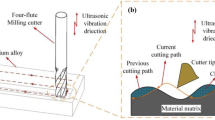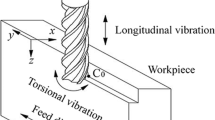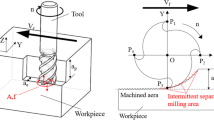Abstract
Titanium alloy milling is prone to burrs at the edges of the workpiece, which can negatively affect surface integrity and dimensional accuracy, and even lead to part scrap. Ultrasonic vibration–assisted milling technology can effectively inhibit burr generation and improve machining quality. However, the research of ultrasonic vibration–assisted milling on burr inhibition is not clear, so this paper establishes a mathematical model of ultrasonic vibration vertical milling titanium alloy top burr size based on the chip deformation process and specifically analyses the effect of ultrasonic machining parameters on burr through experiments. The experimental results show that the depth of cut has the greatest influence on the burr size, and the ultrasonic vibration has the second greatest influence on the burr. The cutting force and the burr size on both sides of the groove show a trend of “decrease and then increase” with the increase of ultrasonic amplitude. When the ultrasonic amplitude was 3 µm, the cutting forces Fx and Fy were reduced by 34.42% and 31.36%, respectively, and the heights and widths of the burrs on the up milling side and on the down milling side were reduced by 75.49%, 44.33% and 89.16%, 47.82%, respectively, when comparing with no ultrasonic machining. The longitudinal-torsional ultrasonic vibration converted the large piled-up, rolled-up, and serrated burrs into intermittent, small-sized flocculent burrs, which significantly improved the burr morphology and weakened the serrated characteristics of the chips.















Similar content being viewed by others
References
Zhao Q, Sun Q, Xin S et al (2022) High-strength titanium alloys for aerospace engineering applications: a review on melting-forging process[J]. Mater Sci Eng, A 845:143260. https://doi.org/10.1016/j.msea.2022.143260
Nguyen HD, Pramanik A, Basak AK et al (2022) A critical review on additive manufacturing of Ti-6Al-4V alloy: microstructure and mechanical properties[J]. J Market Res 18:4641–4661. https://doi.org/10.1016/j.jmrt.2022.04.055
Pimenov DY, Mia M, Gupta MK et al (2021) Improvement of machinability of Ti and its alloys using cooling-lubrication techniques: a review and future prospect[J]. J Market Res 11:719–753. https://doi.org/10.1016/j.jmrt.2021.01.031
Aurich JC, Dornfeld D, Arrazola PJ et al (2009) Burrs—analysis, control and removal[J]. CIRP Ann 58(2):519–542. https://doi.org/10.1016/j.cirp.2009.09.004
Jin SY, Pramanik A, Basak AK et al (2020) Burr formation and its treatments—a review. Int J Adv Manuf Technol 107:2189–2210. https://doi.org/10.1007/s00170-020-05203-2
Li L, Zhang Y, Cui X et al (2023) Mechanical behavior and modeling of grinding force: a comparative analysis[J]. J Manuf Process 102:921–954. https://doi.org/10.1016/j.jmapro.2023.07.074
Yang M, Li C, Zhang Y et al (2019) Predictive model for minimum chip thickness and size effect in single diamond grain grinding of zirconia ceramics under different lubricating conditions[J]. Ceram Int 45(12):14908–14920. https://doi.org/10.1016/j.ceramint.2019.04.226
Mingzheng LIU, Changhe LI, Zhang Y et al (2023) Analysis of grinding mechanics and improved grinding force model based on randomized grain geometric characteristics[J]. Chin J Aeronaut 36(7):160–193. https://doi.org/10.1016/j.cja.2022.11.005
Yabo Z, Qingshun B, Yangyang S et al (2022) Burr formation mechanism and machining parameter effect in slot micro-milling titanium alloy Ti6Al4V[J]. Int J Adv Manuf Technol 123(5–6):2073–2086. https://doi.org/10.1007/s00170-022-10298-w
Davoudinejad A, Tosello G, Annoni M (2017) Influence of the worn tool affected by built-up edge (BUE) on micro end-milling process performance: a 3D finite element modeling investigation. Int J Precis Eng Manuf 18:1321–1332. https://doi.org/10.1007/s12541-017-0157-6
Qiu XY, Yu Z, Li C et al (2021) Influence of main cutting edge structure on hole defects in CFRP/titanium alloy stacks drilling[J]. J Manuf Process 69:503–513. https://doi.org/10.1016/j.jmapro.2021.07.061
Timata M, Saikaew C (2019) Experimental and simulation study on tool life models in drilling of forging brass using uncoated-WC and AlCrN coated-WC Tools[J]. Coatings 9(12):853. https://doi.org/10.3390/coatings9120853
Duan Z, Wang S, Wang Z et al (2024) Tool wear mechanisms in cold plasma and nano-lubricant multi-energy field coupled micro-milling of Al-Li alloy[J]. Tribol Int 109337. https://doi.org/10.1016/j.triboint.2024.109337
Saha S, Deb S, Bandyopadhyay PP (2023) Tool wear induced burr formation and concomitant reduction in MQL wetting capability in micro-milling[J]. Int J Mech Sci 245:108095. https://doi.org/10.1016/j.ijmecsci.2022.108095
dos Santos AJ, de Oliveira DA, Pereira NFS et al (2024) Effect of conventional and trochoidal milling paths on burr formation during micromilling of grade 4 commercially pure titanium. Arab J Sci Eng 49:1727–1742. https://doi.org/10.1007/s13369-023-07989-1
Lotfi M, Charkhian A, Akbari J (2022) Surface analysis in rotary ultrasonic-assisted milling of CFRP and titanium[J]. J Manuf Process 84:174–182. https://doi.org/10.1016/j.jmapro.2022.10.006
Sun J, Li C, Zhou Z et al (2023) Material removal mechanism and force modeling in ultrasonic vibration-assisted micro-grinding biological bone. Chin J Mech Eng 36:129. https://doi.org/10.1186/s10033-023-00957-8
Yu F, Zhang C, Zhu Q et al (2023) Investigation of ultrasonic mechanism and development of tool wear model in ultrasonic elliptic vibration assisted cutting of stainless steel[J]. Tribol Int 189:108962. https://doi.org/10.1016/j.triboint.2023.108962
Zhang Y, Zhao B, Wang Y et al (2017) Effect of machining parameters on the stability of separated and unseparated ultrasonic vibration of feed direction assisted milling. J Mech Sci Technol 31:851–858. https://doi.org/10.1007/s12206-017-0137-x
Zhao B, Bie W, Wang X, Chang B (2020) Design and experimental investigation on vibration system of longitudinal-torsional ultrasonic drilling TC4 titanium alloy[J]. Acta Aeronauticaet Astronautica Sinica 41(1): 423207–423207. https://hkxb.buaa.edu.cn/EN/10.7527/S1000-6893.2019.23207. Accessed 3 Jan 2024
Liu Q, Xu J, Yu H (2020) Experimental study of tool wear and its effects on cutting process of ultrasonic-assisted milling of Ti6Al4V. Int J Adv Manuf Technol 108:2917–2928. https://doi.org/10.1007/s00170-020-05593-3
Bin F, Zhonghang Y, Depeng LI et al (2021) Effect of ultrasonic vibration on finished quality in ultrasonic vibration assisted micromilling of Inconel718[J]. Chin J Aeronaut 34(6):209–219. https://doi.org/10.1016/j.cja.2020.09.021
Atif M, Wang X, Xie L et al (2024) Multiscale modelling and experimental analysis of ultrasonic-assisted drilling of GLARE fibre metal laminates[J]. Compos A Appl Sci Manuf 177:107962. https://doi.org/10.1016/j.compositesa.2023.107962
Wei L, Wang D (2020) Effect of ultrasound-assisted vibration on Ti-6Al-4V/Al2024-T351 laminated material processing with geometric tools. Int J Adv Manuf Technol 106:219–232. https://doi.org/10.1007/s00170-019-04637-7
Xu J, Feng P, Feng F et al (2021) Subsurface damage and burr improvements of aramid fiber reinforced plastics by using longitudinal–torsional ultrasonic vibration milling[J]. J Mater Process Technol 297:117265. https://doi.org/10.1016/j.jmatprotec.2021.117265
Wang X, Jiao F, Zhang S et al (2023) Optimization model for ultrasonic-assisted dry helical milling of CFRP based on genetic algorithm. Int J Adv Manuf Technol. https://doi.org/10.1007/s00170-022-10766-3
Zhu X, Wang W, Jiang R et al (2022) Modeling of burr height in ultrasonic-assisted drilling of DD6 superalloy. Int J Adv Manuf Technol 120:2167–2181. https://doi.org/10.1007/s00170-021-08524-y
Deswal N, Kant R (2023) Radial direction ultrasonic-vibration and laser assisted turning of Al3003 alloy[J]. Materials Research Express 10(4):044004. https://doi.org/10.1088/2053-1591/acce24
Qin S, Zhu L, Wiercigroch M et al (2022) Material removal and surface generation in longitudinal-torsional ultrasonic assisted milling[J]. Int J Mech Sci 227:107375. https://doi.org/10.1016/j.ijmecsci.2022.107375
Ko SL, Dornfeld DA (1991) A study on burr formation mechanism[J]. J Eng Mater Technol 113(1):75–87. https://doi.org/10.1115/1.2903385
Li P, Wang C, Zeng L et al (2023) Analytical modeling of Poisson burr formation in the machining of Al6061 with interface constraint. Int J Adv Manuf Technol 129:353–374. https://doi.org/10.1007/s00170-023-12068-8
Gao G, Xia Z, Su T et al (2021) Cutting force model of longitudinal-torsional ultrasonic-assisted milling Ti-6Al-4V based on tool flank wear[J]. J Mater Process Technol 291:117042. https://doi.org/10.1016/j.jmatprotec.2021.117042
Zhao M, Zhu J, Song S et al (2022) Influence of machining parameters in longitudinal-torsional ultrasonic vibration milling titanium alloy for milling force. Int J Adv Manuf Technol 123:3587–3597. https://doi.org/10.1007/s00170-022-10509-4
Wright PK (1982) Predicting the shear plane angle in machining from workmaterial strain-hardening characteristics[J]. J Manuf Sci Eng 104(3):285–292. https://doi.org/10.1115/1.3185832
Funding
This research was funded by the National Natural Science Foundation of China project “Research on Subsurface Damage Mechanism of High-speed Multidimensional Ultrasound Machining of Ceramic Matrix Composites” (Project Code: 52005164), the Henan Polytechnic University Doctoral Program Fund (B2016-27) “Research on Vehicle Condition Monitoring and Fault Diagnosis Based on Optimized Support Vector Machine”, and the Henan Polytechnic University Doctoral Program Fund (B2012-105).
Author information
Authors and Affiliations
Corresponding author
Ethics declarations
Competing interests
The authors declare no competing interests.
Additional information
Publisher's Note
Springer Nature remains neutral with regard to jurisdictional claims in published maps and institutional affiliations.
Rights and permissions
Springer Nature or its licensor (e.g. a society or other partner) holds exclusive rights to this article under a publishing agreement with the author(s) or other rightsholder(s); author self-archiving of the accepted manuscript version of this article is solely governed by the terms of such publishing agreement and applicable law.
About this article
Cite this article
Song, W., Zhao, M., Zhu, J. et al. Burr formation mechanism and experimental research in longitudinal-torsional ultrasonic-assisted milling Ti-6Al-4 V. Int J Adv Manuf Technol 132, 2315–2331 (2024). https://doi.org/10.1007/s00170-024-13494-y
Received:
Accepted:
Published:
Issue Date:
DOI: https://doi.org/10.1007/s00170-024-13494-y




